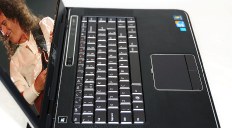
December 29th, 2010 at 7:37 pm - Author Zardon
The Dell XPS 15 is a reasonably slimline unit and while ours shipped with a plain metallic (‘metalloid aluminum’ as Dell call it) finish, you can customise the colour scheme with over 130 designs, the prices for this vary but generally they charge £69.00 for the additional work. It is a great way to personalise the laptop to your tastes.
The machine is only 15×1.3×10.4 inches and is built around an aluminum design, weighing 2.78kg.

One of the many themes shown above. We really like the ‘Tweeqim NorvusOrdo – Mamba’ skin.
The laptop itself is a two tone affair, with a coloured metal chassis highlighted against the silver accented lines around the edges.
The keyboard and trackpad are a high quality design which are intuitive to use and we had no problems typing at speed either. We need to point out the added bonus of a double width return key, which makes high speed typing much easier.


The XPS 15 ships with a protective layer between the screen and keyboard, this helps to minimise any direct key pressure being forced directly onto the glass of the panel during rough shipping. There is a 9 in 1 card reader at the front of the chassis, useful to move files between a camera and the hard drive.


The metallic finish is very attractive, with the fine lines of metal grain apparent under close scrutiny. The sound system is a JBL design which features 2×4 watt speakers on either side of the keyboard and a 12w subwoofer underneath the chassis. Dell have also used a Maxx processing system onboard to help enhance the sound even further, it really is impressive when you consider the limited dimensions. This certainly won’t replace a dedicated speaker system you might have at home, but for on the move it is as good as we have heard.
Along the top of the keyboard is a row of capacitive touch buttons which offer various functionality, such as enabling/disabling the wireless, launching programs or analysing the status of the caps lock key.


It is not often we can note that a laptop has a USB 3.0 port onboard, but Dell have covered the ‘performance’ bases here by offering a single port on the left side of the machine. This is fully backwards compatible with USB 2.0.
The right side of the machine offers an eSATA/USB 2.0 dual port and 3.5mm SPDIF headphone and microphone ports, as well as an LG-Hitachi BluRay/Dual Layer DVD drive nearer the front.


At the rear of the chassis there is a mini displayport connector and an HDMI 1.4 port, sitting next to a gigabit capable Intel LAN socket. You may not see in the image above, but the XPS logo above this is clear, and it lights up when the system is switched on. Along the right we have a second USB 3.0 connector, a power socket and a Kensington locking slot. Power and drive activity lights are above this, although with the screen in an upright position you can’t see them from the front of the laptop.




Opening the machine is a straightforward process, there are three small Philips head screws to remove and the centerpiece pulls off to expose the majority of the upgradeable internals. We will look more at the hardware configuration on the next page.
The Dell battery is a 6 cell unit rated at 11.1 V with a capacity of 56Wh.





























